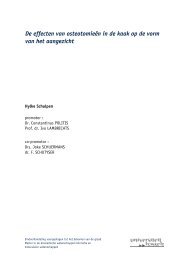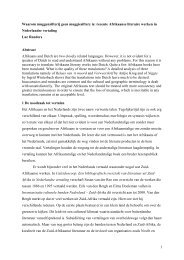Planning Problems in Intermodal Freight Transport ...
Planning Problems in Intermodal Freight Transport ...
Planning Problems in Intermodal Freight Transport ...
Create successful ePaper yourself
Turn your PDF publications into a flip-book with our unique Google optimized e-Paper software.
<strong>in</strong>volve the addition of new physical l<strong>in</strong>ks to the network, the improvement of exist<strong>in</strong>g l<strong>in</strong>ks<br />
(i.e. an <strong>in</strong>crease of capacity), and the location of <strong>in</strong>termodal transfer facilities at specified<br />
nodes of the network. Groothedde et al. [20] propose a collaborative hub network for the<br />
distribution of fast mov<strong>in</strong>g consumer goods. The available transport modes are <strong>in</strong>land<br />
navigation and road transport by trucks. Inland navigation is used for <strong>in</strong>ter-hub transportation<br />
<strong>in</strong> order to achieve economies of scale. Pre- and end-haulage is performed by truck. Parallel to<br />
this hub network, direct truck<strong>in</strong>g is used to ma<strong>in</strong>ta<strong>in</strong> responsiveness and flexibility.<br />
Predictable demand should be sent through the hub network before the order is placed. Peak<br />
demand can be accommodated by direct truck<strong>in</strong>g. The hub network design problem is<br />
formulated as a cost model and solved with an improvement heuristic. The heuristic starts<br />
with a feasible and cost-efficient solution and seeks to improve it by add<strong>in</strong>g barge capacity or<br />
hubs to the network. Simulation models may also be applied to plan the <strong>in</strong>frastructure network<br />
configuration. Tan et al. [21] discuss a modell<strong>in</strong>g methodology for build<strong>in</strong>g discrete-event<br />
simulation models for a state-wide <strong>in</strong>termodal freight transportation network. Their model<br />
simulates the movements of trucks, tra<strong>in</strong>s, barges and ships as well as transhipment of freight<br />
between different modes. The objective of their modell<strong>in</strong>g effort is to demonstrate <strong>in</strong>teractions<br />
between transport modes under various <strong>in</strong>termodal policy chances and to support transport<br />
plann<strong>in</strong>g on a regional and state-wide level.<br />
Two research papers focus on the impact of transport growth on the h<strong>in</strong>terland<br />
network. Parola and Sciomachen [22] analyze the impact of a possible future growth <strong>in</strong> sea<br />
traffic on land <strong>in</strong>frastructure <strong>in</strong> the north-western Italian port system. The central question is<br />
how to achieve a modal split equilibrium between transport by rail and transport by road.<br />
Discrete event simulation is used to model a set of maritime term<strong>in</strong>als, their <strong>in</strong>terconnections<br />
and land <strong>in</strong>frastructures. The simulation model is validated by means of the present









